Kenwood USA 434901 VHF FM Transceiver User Manual TK 2400 Instruction Manual
Kenwood USA Corporation VHF FM Transceiver TK 2400 Instruction Manual
TK-2400 Instruction Manual

INSTRUCTION MANUAL
© B62-2478-00 (K)
09 08 07 06 05 04 03 02 01 00
VHF FM TRANSCEIVER
TK-2400
UHF FM TRANSCEIVER
TK-3400
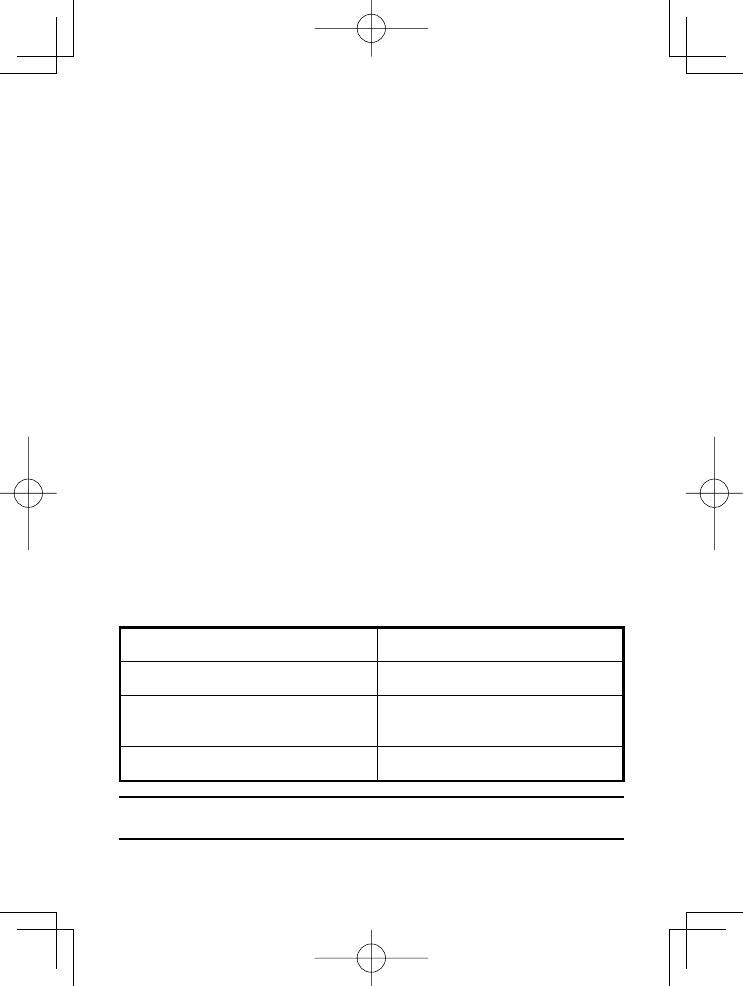
THANK YOU
We are grateful for your purchase of this KENWOOD product
and welcome you to the Business Radio Service (BRS).
Your KENWOOD 2-way Business Radio is called a “transceiver”,
meaning “transmitter & receiver”. We believe this easy-to-
use transceiver will provide you with dependable and reliable
communications. This KENWOOD transceiver is a precision
device. Treat it with care, and you will enjoy years of reliable
operation.
FEATURES
• 4 channels (K) or 16 channels (K2) with 27 VHF operating
frequencies (TK-2400) or 90 UHF operating frequencies
(TK-3400) and 39 tones/ 168 codes settings for each channel
allowing you to ignore unwanted calls.
• Built in voice scrambler gives you complete privacy for your
conversations.
• Hands free operation when using an optional headset.
• Voice announcement lets you know which channel you have
selected and which settings you have made when reassigning
key functions and channel settings.
OPERATING CONDITIONS
Open locations (no obstructions) Up to 6 miles (9.6 km)
Residential areas (near buildings) Up to 1.5 miles (2.4 km)
In steel/ concrete reinforced
buildings
Up to 250,000 square feet
(23,220 m2)
In high rises Up to 20 floors
Note: The listed ranges are based on field testing and may vary with
your operating conditions and individual transceiver.

i
FCC LICENSE INFORMATION
Your KENWOOD transceiver operates on communications
frequencies which are subject to FCC (Federal Communications
Commission) Rules & Regulations. FCC Rules require that all
operators using Private Land Mobile radio frequencies obtain a
radio license before operating their equipment. Application for
license must be made on FCC form 601, schedules D and H,
and Remittance form 159.
FAX: Forms can be obtained by fax from the FCC Fax-On-
Demand system. Call 1-202-418-0177 from your fax machine
and request document number 000601 for the form, schedules,
and instructions.
MAIL: Forms can be ordered by telephone, and will be sent to
you by first class mail. Call the FCC Forms Hotline at
1-800-418-FORM (1-800-418-3676).
INTERNET: Form 601 and instructions can be downloaded
from the FCC Forms website at
http://www.fcc.gov/formpage.html
Before filling out your Form 601 application Technical Data
section, you must decide on which frequencies you will operate.
See the frequency charts on pages 14 and 15.
QUESTIONS? Call the FCC for license application questions
at 1-888-CALL-FCC (1-888-225-5322).
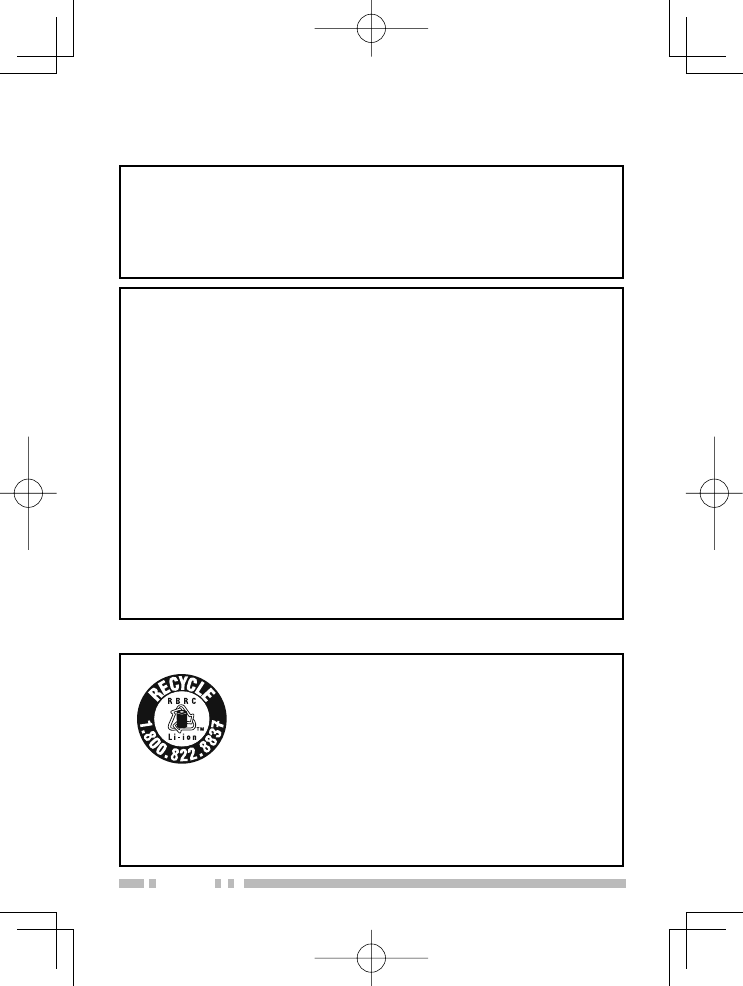
ii
One or more of the following statements may be
applicable:
FCC WARNING
This equipment generates or uses radio frequency energy. Changes
or modifications to this equipment may cause harmful interference
unless the modifications are expressly approved in the instruction
manual. The user could lose the authority to operate this equipment if
an unauthorized change or modification is made.
INFORMATION TO THE DIGITAL DEVICE USER REQUIRED BY
THE FCC
This equipment has been tested and found to comply with the limits
for a Class B digital device, pursuant to Part 15 of the FCC Rules.
These limits are designed to provide reasonable protection against
harmful interference in a residential installation.
This equipment generates, uses and can generate radio frequency
energy and, if not installed and used in accordance with the instructions,
may cause harmful interference to radio communications. However,
there is no guarantee that the interference will not occur in a particular
installation. If this equipment does cause harmful interference to
radio or television reception, which can be determined by turning the
equipment off and on, the user is encouraged to try to correct the
interference by one or more of the following measures:
• Reorient or relocate the receiving antenna.
• Increase the separation between the equipment and receiver.
• Connect the equipment to an outlet on a circuit different from that
to which the receiver is connected.
• Consult the dealer for technical assistance.
ATTENTION:
The RBRC Recycle seal found on KENWOOD lithium-
ion (Li-ion) battery packs indicates KENWOOD’s
voluntary participation in an industry program to collect
and recycle Li-ion batteries after their operating life
has expired. The RBRC program is an alternative to
disposing Li-ion batteries with your regular refuse or in
municipal waste streams, which is illegal in some areas.
For information on Li-ion battery recycling in your area, call (toll free)
1-800-8-BATTERY (1-800-822-8837).
KENWOOD’s involvement in this program is part of our commitment to
preserve our environment and conserve our natural resources.

iii
NOTICES TO THE USER
◆ Government law prohibits the operation of unlicensed radio
transmitters within the territories under government control.
◆ Illegal operation is punishable by fine and/or imprisonment.
◆ Refer service to qualified technicians only.
Safety: It is important that the operator is aware of, and
understands, hazards common to the operation of any
transceiver.
PRECAUTIONS
• Do not charge the transceiver and battery pack when they are wet.
• Ensure that there are no metallic items located between the
transceiver and the battery pack.
• Do not use options not specified by KENWOOD.
• If the die-cast chassis or other transceiver part is damaged, do not
touch the damaged parts.
• If a headset or headphone is connected to the transceiver, reduce
the transceiver volume. Pay attention to the volume level when
turning the squelch off.
• Do not place the microphone cable around your neck while near
machinery that may catch the cable.
• Do not place the transceiver on unstable surfaces.
• Ensure that the end of the antenna does not touch your eyes.
• When the transceiver is used for transmission for many hours, the
radiator and chassis will become hot. Do not touch these locations
when replacing the battery pack.
• Do not immerse the transceiver in water.
• Always switch the transceiver power off before installing optional
accessories.
• The charger is the device that disconnects the unit from the AC
mains line. The AC plug should be readily accessible.

iv
Turn the transceiver power off in the following locations:
• In explosive atmospheres (inflammable gas, dust particles,
metallic powders, grain powders, etc.).
• While taking on fuel or while parked at gasoline service stations.
• Near explosives or blasting sites.
• In aircrafts. (Any use of the transceiver must follow the instructions
and regulations provided by the airline crew.)
• Where restrictions or warnings are posted regarding the use of
radio devices, including but not limited to medical facilities.
• Near persons using pacemakers.
• Do not disassemble or modify the transceiver for any reason.
• Do not place the transceiver on or near airbag equipment while
the vehicle is running. When the airbag inflates, the transceiver
may be ejected and strike the driver or passengers.
• Do not transmit while touching the antenna terminal or if
any metallic parts are exposed from the antenna covering.
Transmitting at such a time may result in a high-frequency burn.
• If an abnormal odor or smoke is detected coming from the
transceiver, switch the transceiver power off immediately,
remove the battery pack from the transceiver, and contact your
KENWOOD dealer.
• Use of the transceiver while you are driving may be against traffic
laws. Please check and observe the vehicle regulations in your
area.
• Do not expose the transceiver to extremely hot or cold conditions.
• Do not carry the battery pack (or battery case) with metal objects,
as they may short the battery terminals.
• Danger of explosion if the battery is incorrectly replaced; replace
only with the same type.
• When operating the transceiver in areas where the air is dry, it is
easy to build up an electric charge (static electricity). When using
an earphone accessory in such conditions, it is possible for the
transceiver to send an electric shock through the earphone and to
your ear. We recommend you use only a speaker/microphone in
these conditions, to avoid electric shocks.
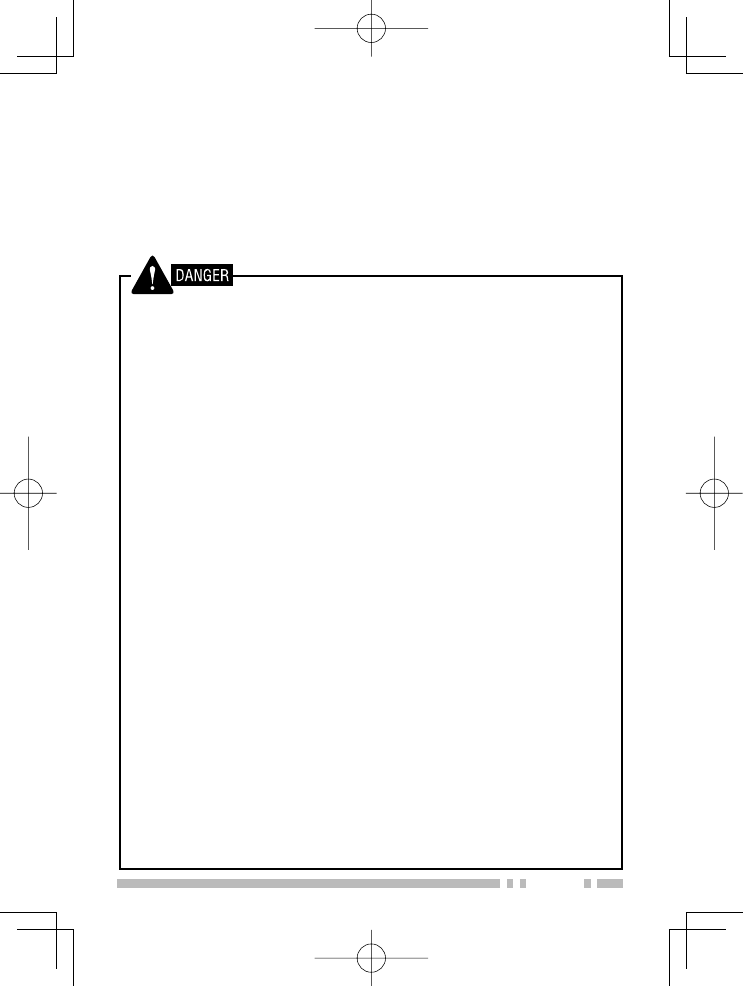
v
Information concerning the battery pack:
The battery pack includes flammable objects such as organic
solvent. Mishandling may cause the battery to rupture
producing flames or extreme heat, deteriorate, or cause other
forms of damage to the battery. Please observe the following
prohibitive matters.
• Do not disassemble or reconstruct battery!
The battery pack has a safety function and protection circuit to
avoid danger. If they suffer serious damage, the battery may
generate heat or smoke, rupture, or burst into flame.
• Do not short-circuit the battery!
Do not join the + and – terminals using any form of metal (such
as a paper clip or wire). Do not carry or store the battery pack in
containers holding metal objects (such as wires, chain-necklace or
hairpins). If the battery pack is short-circuited, excessive current will
flow and the battery may generate heat or smoke, rupture, or burst
into flame. It will also cause metal objects to heat up.
• Do not incinerate or apply heat to the battery!
If the insulator is melted, the gas release vent or safety function is
damaged, or the electrolyte is ignited, the battery may generate
heat or smoke, rupture, or burst into flame.
• Do not use or leave the battery near fire, stoves, or other heat
generators (areas reaching over 80°C/ 176°F)!
If the polymer separator is melted due to high temperature, an
internal short-circuit may occur in the individual cells and the
battery may generate heat or smoke, rupture, or burst into flame.
• Do not immerse the battery in water or get it wet by other
means!
If the battery’s protection circuit is damaged, the battery may
charge at extreme current (or voltage) and an abnormal chemical
reaction may occur. The battery may generate heat or smoke,
rupture, or burst into flame.
• Do not charge the battery near fire or under direct sunlight!
If the battery’s protection circuit is damaged, the battery may
charge at extreme current (or voltage) and an abnormal chemical
reaction may occur. The battery may generate heat or smoke,
rupture, or burst into flame.
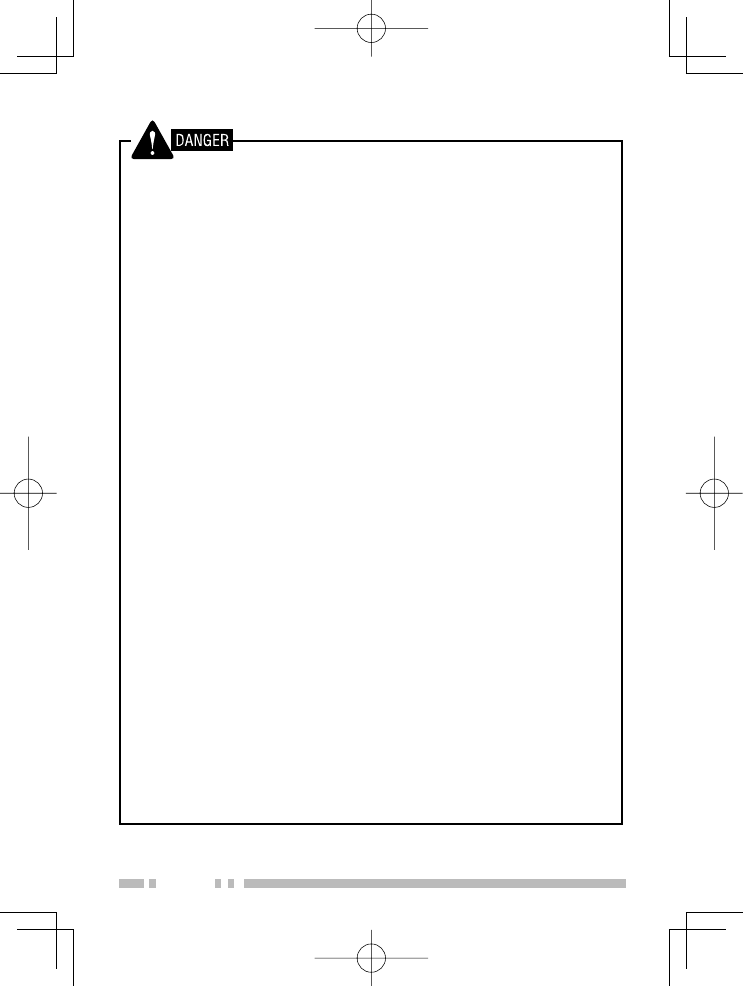
vi
• Use only the specified charger and observe charging
requirements!
If the battery is charged in unspecified conditions (under high
temperature over the regulated value, excessive high voltage or
current over regulated value, or with a remodeled charger), it may
overcharge or an abnormal chemical reaction may occur. The
battery may generate heat or smoke, rupture, or burst into flame.
• Do not pierce the battery with any object, strike it with an
instrument, or step on it!
This may break or deform the battery, causing a short-circuit. The
battery may generate heat or smoke, rupture, or burst into flame.
• Do not jar or throw the battery!
An impact may cause the battery to leak, generate heat or smoke,
rupture, and/or burst into flame. If the battery’s protection circuit
is damaged, the battery may charge at an abnormal current (or
voltage), and an abnormal chemical reaction may occur. The
battery may generate heat or smoke, rupture, or burst into flame.
• Do not use the battery pack if it is damaged in any way!
The battery may generate heat or smoke, rupture, or burst into
flame.
• Do not solder directly onto the battery!
If the insulator is melted or the gas release vent or safety function
is damaged, the battery may generate heat or smoke, rupture, or
burst into flame.
• Do not reverse the battery polarity (and terminals)!
When charging a reversed battery, an abnormal chemical reaction
may occur. In some cases, an unexpected large amount of
current may flow upon discharging. The battery may generate
heat or smoke, rupture, or burst into flame.
• Do not reverse-charge or reverse-connect the battery!
The battery pack has positive and negative poles. If the battery
pack does not smoothly connect with a charger or operating
equipment, do not force it; check the polarity of the battery. If the
battery pack is reverse-connected to the charger, it will be reverse-
charged and an abnormal chemical reaction may occur. The
battery may generate heat or smoke, rupture, or burst into flame.
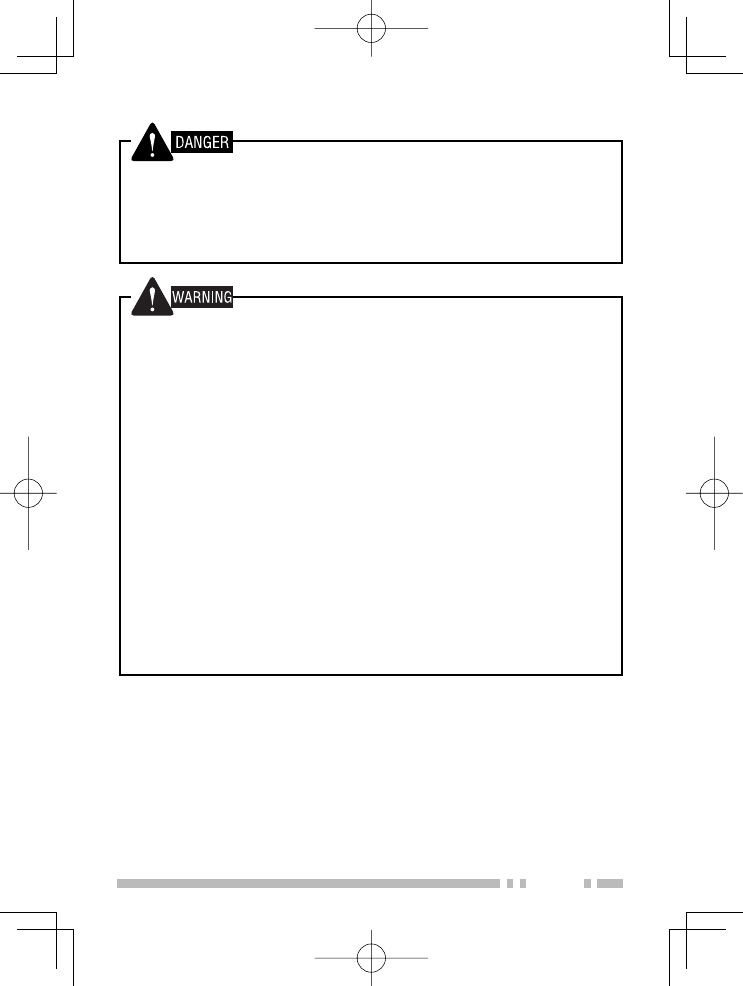
vii
• Do not touch a ruptured and leaking battery!
If the electrolyte liquid from the battery gets into your eyes, wash
your eyes with fresh water as soon as possible, without rubbing
your eyes. Go to the hospital immediately. If left untreated, it may
cause eye-problems.
• Do not charge the battery for longer than the specified time!
If the battery pack has not finished charging even after the
regulated time has passed, stop it. The battery may generate heat
or smoke, rupture, or burst into flame.
• Do not place the battery pack into a microwave or high
pressure container!
The battery may generate heat or smoke, rupture, or burst into
flame.
• Keep ruptured and leaking battery packs away from fire!
If the battery pack is leaking (or the battery emits a bad odor),
immediately remove it from flammable areas. Electrolyte leaking
from battery can easily catch on fire and may cause the battery to
generate smoke or burst into flame.
• Do not use an abnormal battery!
If the battery pack emits a bad odor, appears to have different
coloring, is deformed, or seems abnormal for any other reason,
remove it from the charger or operating equipment and do not use
it. The battery may generate heat or smoke, rupture, or burst into
flame.

viii
CONTENTS
UNPACKING AND CHECKING EQUIPMENT .......................... 1
PREPARATION .......................................................... 2
ORIENTATION ........................................................... 6
BASIC OPERATIONS ................................................... 8
VOICE OPERATED TRANSMISSION (VOX) .......................... 9
BACKGROUND OPERATIONS ........................................10
CHANNEL SETUP MODE .............................................. 11
KEY ASSIGNMENT MODE ............................................ 20
TROUBLESHOOTING GUIDE ......................................... 25
ALL RESET MODE ..................................................... 26
OPTIONAL ACCESSORIES ............................................ 26
Firmware Copyrights
The title to and ownership of copyrights for firmware embedded in
KENWOOD product memories are reserved for JVC KENWOOD
Corporation.
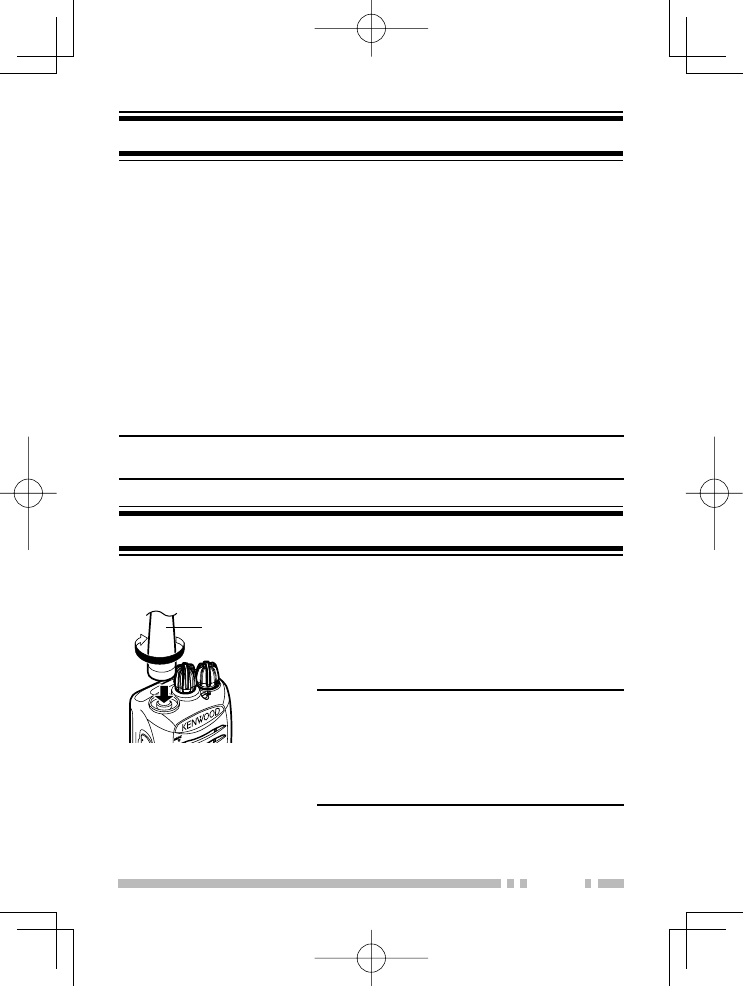
1
UNPACKING AND CHECKING EQUIPMENT
Carefully unpack the transceiver. If any of the items listed
below are missing or damaged, file a claim with the carrier
immediately.
SUPPLIED ACCESSORIES
• Battery charger/ AC adapter (KSC-35S) ................................1
• Li-ion Battery pack (KNB-45L) ................................................ 1
• Speaker/ microphone jack cover ............................................1
• Speaker/ microphone locking bracket ....................................1
• Belt clip (KBH-10) ...................................................................1
• Screw (M3 x 8 mm) ................................................................. 2
• Warranty card .........................................................................1
• Instruction manual ..................................................................1
Note: Refer to "PREPARATION" for accessory installation
instructions.
PREPARATION
INSTALLING THE ANTENNA
Antenna Screw the antenna into the connector
on the top of the transceiver by
holding the antenna at its base and
turning it clockwise until secure.
Note: The antenna is neither a handle,
a key ring retainer, nor a speaker/
microphone attachment point. Using
the antenna in these ways may
damage the antenna and degrade your
transceiver’s performance

2
INSTALLING/ REMOVING THE BATTERY PACK
◆ Do not short the battery terminals or dispose of the battery by
fire.
◆ Never attempt to remove the casing from the battery pack.
1 Align the battery pack with
the back of the transceiver,
then press the battery pack
and transceiver firmly together
until the release latch on the
base of the transceiver locks.
2 To remove the battery pack,
lift the safety catch on the
base of the transceiver,
then press the release latch
underneath the safety catch.
3 While pressing the release
latch, pull the battery pack
away from the transceiver.
CHARGING THE BATTERY PACK
The battery pack is not charged at the factory; charge it before
use. Average battery pack life (calculated using 5% transmit
time, 5% receive time, and 90% standby time) is 17 hours.
ATTENTION: Always switch OFF a transceiver equipped with a
battery pack before inserting the transceiver into the charger.
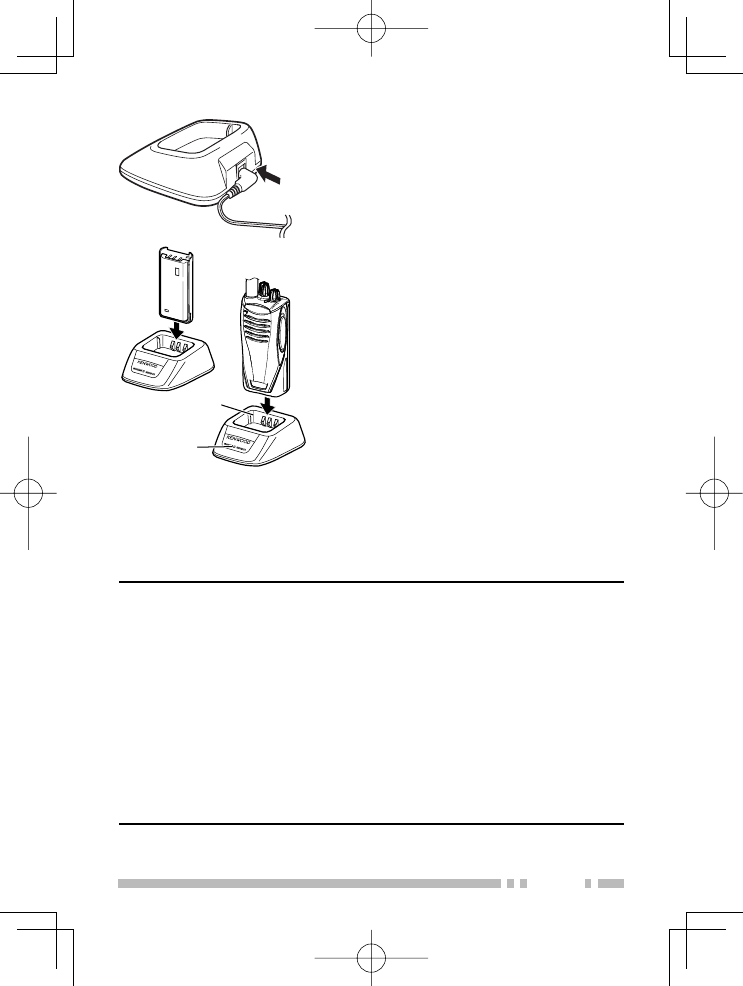
3
1 Plug the AC adapter cable into
the jack located on the rear of the
charger.
2 Plug the AC adapter into an AC
outlet.
3 Slide a battery pack or a
transceiver equipped with a
battery pack into the charging slot
of the charger.
• Make sure the metal contacts of
the battery pack mate securely
with the charger terminals.
• The indicator lights red and
charging begins.
4 When charging is completed, the
indicator lights green. Remove
the battery pack or the transceiver
from the charging slot of the
charger.
Charging slot
Indicator
• It takes approximately 3 hours to charge the battery pack.
• When the charger will not be used for a long time, unplug the AC
adapter from the AC outlet.
Note:
◆ When the indicator blinks red, the battery pack is either
defective or the battery pack contacts are not properly mated
with those of the charger.
◆ When the indicator flashes green and orange, the battery pack
has not satisfied the charging start temperature. Remove the
battery pack from the charger and wait until it reaches a normal
temperature before charging it again.
◆ The ambient temperature should be between 41°F and 104°F
(5°C and 40°C) while charging is in progress. Charging outside
this range may not fully charge the battery.
◆ The battery pack life is over when its operating time decreases even
though it is fully and correctly charged. Replace the battery pack.
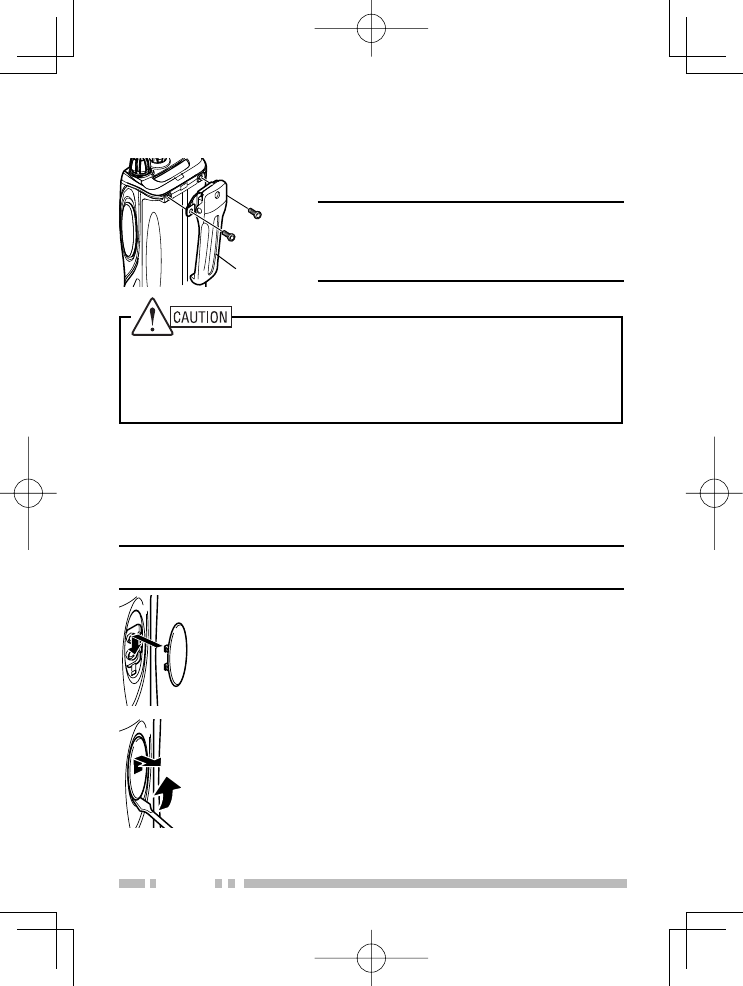
4
INSTALLING THE BELT CLIP
If necessary, attach the belt clip using
the two supplied M3 x 8 mm screws.
Note: If the belt clip is not installed, its
mounting location may get hot during
continuous transmission or when left
sitting in a hot environment.
Do not use glue which is designed to prevent screw loosening when
installing the belt clip, as it may cause damage to the transceiver.
Acrylic ester, which is contained in these glues, may crack the
transceiver’s back panel.
INSTALLING THE CAP OVER THE SPEAKER/
MICROPHONE JACKS
Install the cap over the speaker/ microphone jacks when not
using an optional speaker/ microphone.
Note: To keep the transceiver water resistant, you must cover the
speaker/ microphone jacks with the supplied cap.
1 Place the cap over the jacks so that the locking tabs
insert into the transceiver grooves.
2 While holding the cap in place, push it towards the
bottom of the transceiver until the tabs on the cap
click into place.
• To remove the cap, hold the top of the cap in
place with your finger while inserting a
3 mm or smaller flat blade screwdriver under the
bottom of the cap. Slowly slide the screwdriver
in until its tip touches the tab inside the cap, then
gently pry the cap up (handle of screwdriver
moving away from the transceiver) to remove the
cap.
Belt clip
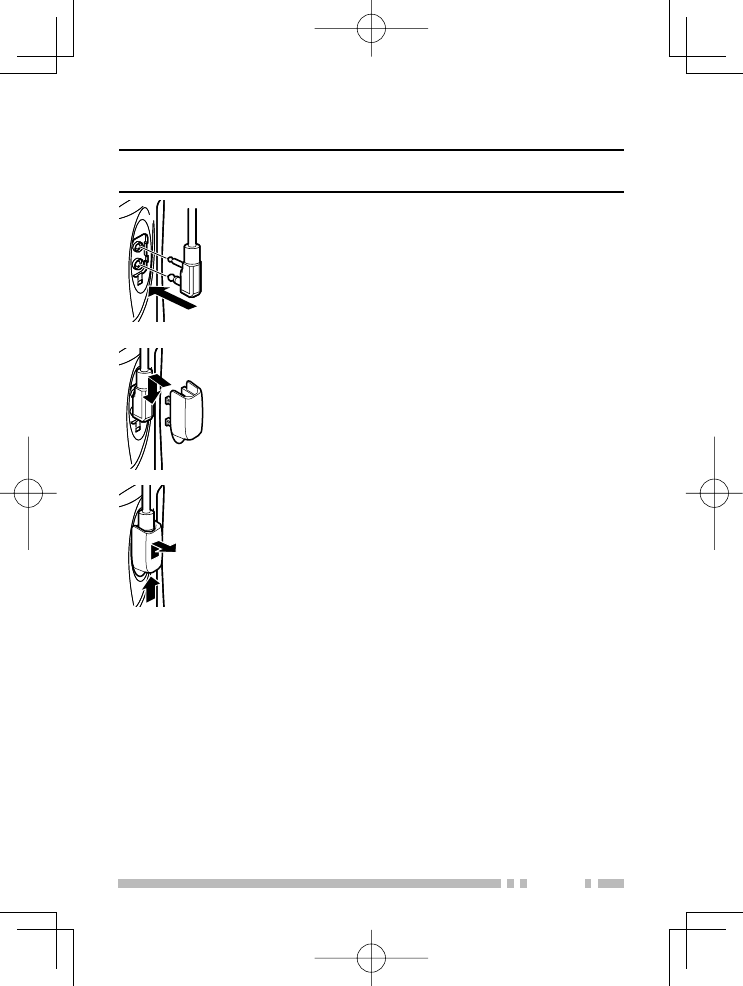
5
INSTALLING THE (OPTIONAL) SPEAKER/ MICROPHONE
Note: The transceiver is not fully water resistant when using a
speaker/ microphone or headset.
1 Insert the speaker/ microphone plugs into the
speaker/ microphone jacks of the transceiver.
2 Place the locking bracket over the speaker/
microphone plugs so that the locking tabs insert
into the transceiver grooves.
3 While holding the locking bracket in place, push it
towards the bottom of the transceiver until the tabs
on the bracket click into place.
• To remove the locking bracket, push the
bracket up from the base.

6
ORIENTATION
Battery pack
Channel selector
Rotate to change the operating channel.
• To change the operating frequency or QT/DQT settings of a
channel, refer to “CHANNEL SETUP MODE” on page 11.
• Channel Announcement: When changing channels, the
transceiver will announce the newly selected channel number.
LED indicator
For the LED indicator status, refer to page 8.
Power switch/ Volume control
Turn clockwise to switch the transceiver ON. To switch the
transceiver OFF, turn counterclockwise until a click sounds.
Rotate to adjust the volume level.
PTT (Push to Talk) switch
Press and hold, then speak into the microphone to transmit.
Antenna

7
Side 1 key
Press to activate its programmable function.
The default setting is Super Lock.
• For function descriptions and details on how to change the
function of the Side 1 key, refer to “KEY ASSIGNMENT MODE”
on page 20.
Side 2 key
Press to activate its programmable function.
The default setting is Scan Temporary Delete.
• For function descriptions and details on how to change the
function of the Side 2 key, refer to “KEY ASSIGNMENT MODE”
on page 20.
Speaker/ microphone jacks
Insert the Speaker/ microphone or Headset plug into this
jack.

8
BASIC OPERATIONS
1 Turn the Power switch/ Volume control
clockwise to switch the transceiver power
ON.
• A beep sounds.
2 Rotate the Channel selector to select your
desired channel.
• When you receive an appropriate signal, you
will hear audio from the speaker. Adjust the
volume as necessary.
3 To make a call, press and hold the PTT
switch, then speak into the microphone using
your normal speaking voice.
• Hold the microphone approximately 1.5 inches
(3 to 4 cm) from your lips.
4 Release the PTT switch to receive.
Note: When the battery pack voltage becomes too
low, the Low Battery Warning sounds an alert tone
every 30 seconds and the LED indicator blinks red.
LED Indicator Status
Indicator Color Meaning
Lights red Transmitting
Lights green Receiving a call
Blinks red Battery power is low while transmitting
Blinks green Scanning
Blinks red/orange The selected channel has not been
programmed and cannot be used.

9
VOICE OPERATED TRANSMISSION (VOX)
VOX operation allows you to transmit hands-free. VOX can
only be used if you are using a supported headset. This
function can be turned off for specific channels.
To activate VOX and set the VOX Gain level, perform the
following steps:
1 Connect the headset to the transceiver .
• The VOX function does not activate when a headset is not
connected to the accessory terminal of the transceiver.
2 With the transceiver power OFF, press and hold the Side 1
key while turning the transceiver power ON.
3 Continue to hold the Side 1 key until a beep sounds.
• The LED indicator lights turn orange.
• When the Side 1 key is released, the transceiver will
announces the VOX Gain level (the default level is OFF, so, a
double beep sounds).
4 Press the Side 1 key to select the VOX Gain level of the radio
(from 1~10 or Off).
• Press the Side 2 key to enable or disable the VOX function for
the current channel (you can change this setting for each channel
by selecting a channel with the Channel selector). When turned
ON, a beep sounds. When turned OFF, a double beep sounds.
5 Press the PTT switch to save the setting.
• A beep will sound.
• The transceiver announces the new VOX Gain level.
6 Turn the transceiver power OFF and then ON again to
activate VOX.
Note:
◆ The transceiver will automatically return to normal operation if
no action is performed for 20 seconds.
◆ VOX Gain level 1 is the least sensitive and VOX Gain level 10 is
the most sensitive.
◆ If a headset is connected to the transceiver while the VOX
function is switched ON and the VOX Gain level is configured
to a higher, more sensitive level, louder received signals may
cause the transceiver to start transmission.

10
BACKGROUND OPERATIONS
TIME-OUT TIMER (TOT)
The Time-out Timer prevent callers from using a channel for an
extended duration (60 seconds). If you continuously transmit
for the duration, transmission will stop and an alert tone will
sound. To stop the tone, release the PTT switch.
LOW BATTERY WARNING
While operating the transceiver, the Low Battery Warning
sounds an alert tone every 30 seconds and the LED indicator
blinks red when the battery needs recharged or replaced.
CHANNEL ANNOUNCEMENT
When changing the channel, the transceiver will announce the
newly selected channel number. Likewise, the transceiver will
announce the current channel after you turn the transceiver
power ON.
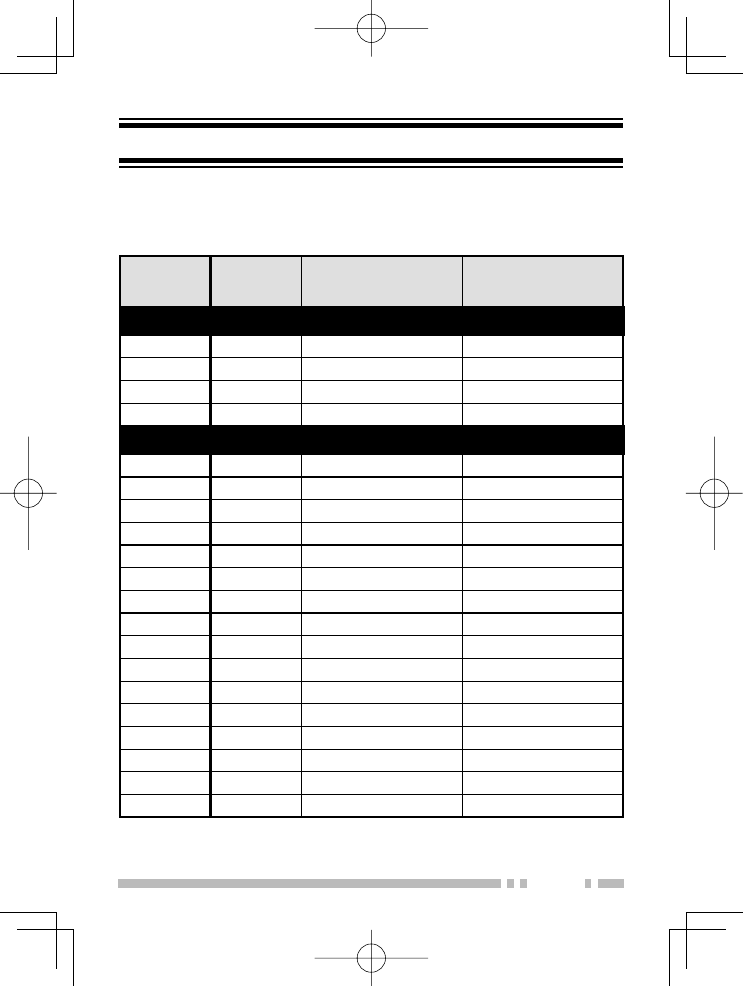
11
CHANNEL SETUP MODE
This transceiver allows you to reprogram each of the channels
with different frequencies and QT (Quiet Talk)/ DQT (Digital
Quiet Talk) settings. The table below lists the default channel
settings.
Channel
Number
Table
Number Frequency (MHz) QT/DQT Setting
TK-2400 (K) 4 channel model
120 154.4900 67.0 Hz
221 154.5150 67.0 Hz
31 151.6250 67.0 Hz
42 151.9550 67.0 Hz
TK-2400 (K2) 16 channel model
120 154.4900 67.0 Hz
221 154.5150 67.0 Hz
31 151.6250 67.0 Hz
42 151.9550 67.0 Hz
510 151.5125 67.0 Hz
612 151.6850 67.0 Hz
715 151.7750 67.0 Hz
826 158.4000 67.0 Hz
91 151.6250 77.0 Hz
10 1 151.6250 88.5 Hz
11 1 151.6250 179.9 Hz
12 2 151.9550 82.5 Hz
13 2 151.9550 94.8 Hz
14 2 151.9550 179.9 Hz
15 5 151.7000 67.0 Hz
16 6 151.7600 67.0 Hz
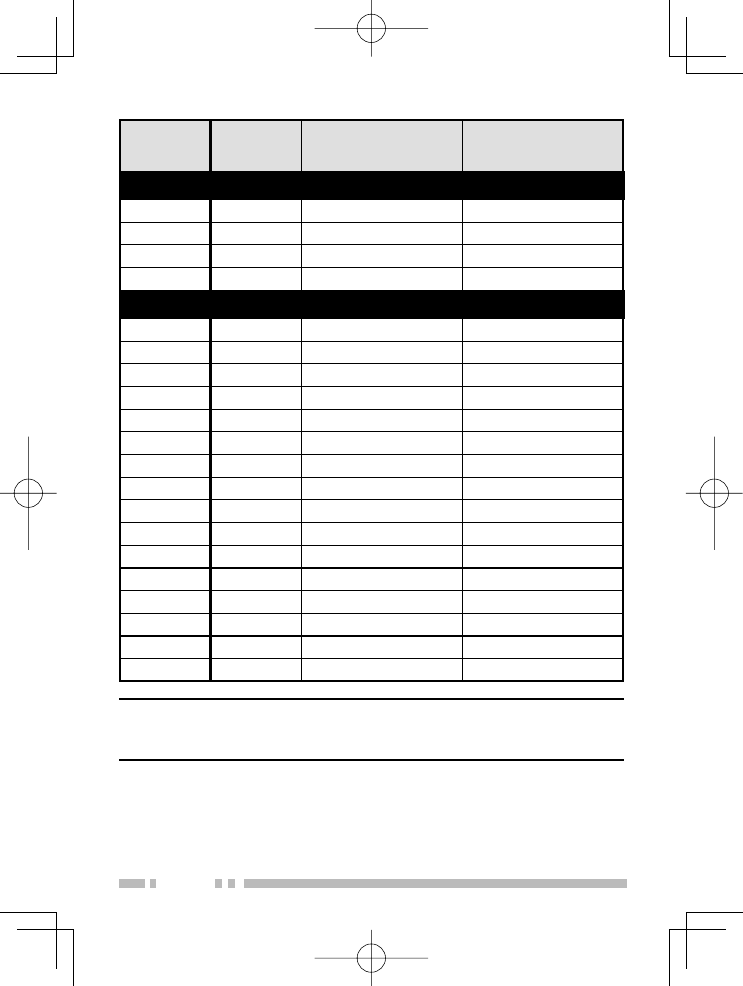
12
Channel
Number
Table
Number Frequency (MHz) QT/DQT Setting
TK-3400 (K) 4 channel model
12 464.5500 67.0 Hz
28 467.9250 67.0 Hz
39 461.0375 67.0 Hz
410 461.0625 67.0 Hz
TK-3400 (K2) 16 channel model
12 464.5500 67.0 Hz
28 467.9250 67.0 Hz
39 461.0375 67.0 Hz
410 461.0625 67.0 Hz
511 461.0875 67.0 Hz
612 461.1125 67.0 Hz
713 461.1375 67.0 Hz
814 461.1625 67.0 Hz
91 464.5000 67.0 Hz
10 3 467.7625 67.0 Hz
11 4 467.8125 67.0 Hz
12 5 467.8500 67.0 Hz
13 6 467.8750 67.0 Hz
14 7 467.9000 67.0 Hz
15 15 461.1875 67.0 Hz
16 16 461.2125 67.0 Hz
Note: Due to FCC regulations, the default values of TK-2400/ TK-
2300 (VHF) are different from TK-2200 (VHF) series. Make sure to
choose a compatible frequency to interoperate with each other.

13
CHANNEL OPERATING FREQUENCIES
To change the operating frequency of a channel:
1 With the transceiver power OFF, press and hold the PTT
switch and Side 1 key while turning the transceiver power
ON.
• Continue to hold the PTT switch and Side 1 key until the LED
lights orange and the transceiver announces “Self”.
2 Release the PTT switch and Side 1 key.
• The transceiver announces “Channel”.
• Pressing the Side 1 key or Side 2 key will toggle between QT,
DQT, and Channel setup.
3 Press and release the PTT switch, then rotate the Channel
selector to your desired channel.
• Upon pressing and releasing the PTT switch, a beep will sound
and the transceiver announces “Table zero”.
4 Press the Side 1 or Side 2 key to increment/ decrement the
Table number, to select the new channel frequency.
• Press and hold the Side 1 or Side 2 key to increment/
decrement the number by 5 at a time.
• Table numbers and their corresponding operating frequencies
are provided in the table on page 14.
• A voice announcement will inform you of the currently selected
Table number.
5 Press the PTT switch to save the setting.
• A beep will sound.
• Repeat steps 3 to 5 to set up another channel.
6 Turn the transceiver power OFF and then ON again to
activate the new settings.
Note: The transceiver will automatically return to normal operation
if no action is performed for 20 seconds.
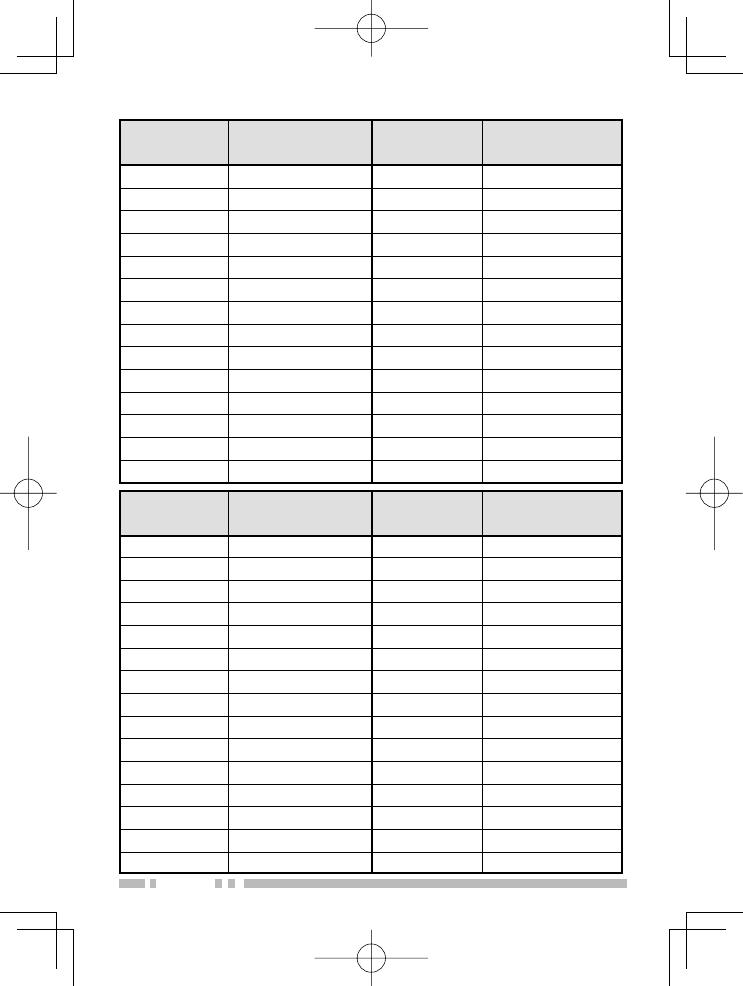
14
TK-2400
Table Number
Operating
Frequency (MHz)
TK-2400
Table Number
Operating
Frequency (MHz)
0OFF 14 151.7450
1151.6250 15 151.7750
2151.9550 16 151.8650
3152.8850 17 151.8950
4152.9150 18 151.9250
5151.7000 19 152.9000
6151.7600 20 154.4900
7152.9450 21 154.5150
8151.8350 22 154.5275
9151.8050 23 154.5400
10 151.5125 24 153.0050
11 151.6550 25 154.5475
12 151.6850 26 158.4000
13 151.7150 27 158.4075
TK-3400
Table Number
Operating
Frequency (MHz)
TK-3400
Table Number
Operating
Frequency (MHz)
0OFF 15 461.1875
1464.5000 16 461.2125
2464.5500 17 461.2375
3467.7625 18 461.2625
4467.8125 19 461.2875
5467.8500 20 461.3125
6467.8750 21 461.3375
7467.9000 22 461.3625
8467.9250 23 462.7625
9461.0375 24 462.7875
10 461.0625 25 462.8125
11 461.0875 26 462.8375
12 461.1125 27 462.8625
13 461.1375 28 462.8875
14 461.1625 29 462.9125

15
TK-3400
Table Number
Operating
Frequency (MHz)
TK-3400
Table Number
Operating
Frequency (MHz)
30 464.4875 61 467.1875
31 464.5125 62 467.4625
32 464.5375 63 467.4875
33 464.5625 64 467.5125
34 466.0375 65 451.1875
35 466.0625 66 451.2375
36 466.0875 67 451.2875
37 466.1125 68 451.3375
38 466.1375 69 451.4375
39 466.1625 70 451.5375
40 466.1875 71 451.6375
41 466.2125 72 452.3125
42 466.2375 73 452.5375
43 466.2625 74 452.4125
44 466.2875 75 452.5125
45 466.3125 76 452.7625
46 466.3375 77 452.8625
47 466.3625 78 456.1875
48 467.7875 79 456.2375
49 467.8375 80 456.2875
50 467.8625 81 468.2125
51 467.8875 82 468.2625
52 467.9125 83 468.3125
53 469.4875 84 468.3625
54 469.5125 85 468.4125
55 469.5375 86 468.4625
56 469.5625 87 468.5125
57 462.1875 88 468.5625
58 462.4625 89 468.6125
59 462.4875 90 468.6625
60 462.5125

16
QT/ DQT SETTINGS
Quiet Talk (QT) and Digital Quiet Talk (DQT) are functions that
reject undesired signals on your channel. You will hear a call
only when you receive a signal that contains a matching QT
tone or DQT code. If a call containing a different tone or code
is received, squelch will not open and you will not hear the call.
Likewise, when transmitting using QT or DQT, the receiving
station must have a matching tone or code to hear your call.
Be aware that other parties can still hear your calls if they set
up their transceiver with the same tone or code.
To change the QT/DQT settings of a channel:
1 With the transceiver power OFF, press and hold the PTT
switch and Side 1 key while turning the transceiver power
ON.
• Continue to hold the PTT switch and Side 1 key until the LED
lights orange and the transceiver announces “Self”.
2 Release the PTT switch and Side 1 key.
• The transceiver announces “Channel”.
• Pressing the Side 1 key or Side 2 key will toggle between QT,
DQT, and Channel setup.
3 Press the Side 1 or Side 2 key to select QT or DQT setup.
• The transceiver announces “QT” or “DQT”, depending on your
selection.
4 Press and release the PTT switch, then rotate the Channel
selector to your desired channel.
• Upon releasing the PTT switch, the transceiver announces “QT
One” or “DQT One”, depending on your selection.
5 Press the Side 1 or Side 2 key to increment/ decrement the
Tone number, to select the new tone or code.
• Tone numbers and their corresponding tones/ codes are
provided in the table on pages 17 and 18.
• Press and hold the Side 1 or Side 2 key to increment/
decrement the QT or DQT number by 5 at a time.
• A voice announcement will inform you of the currently selected
QT or DQT number.
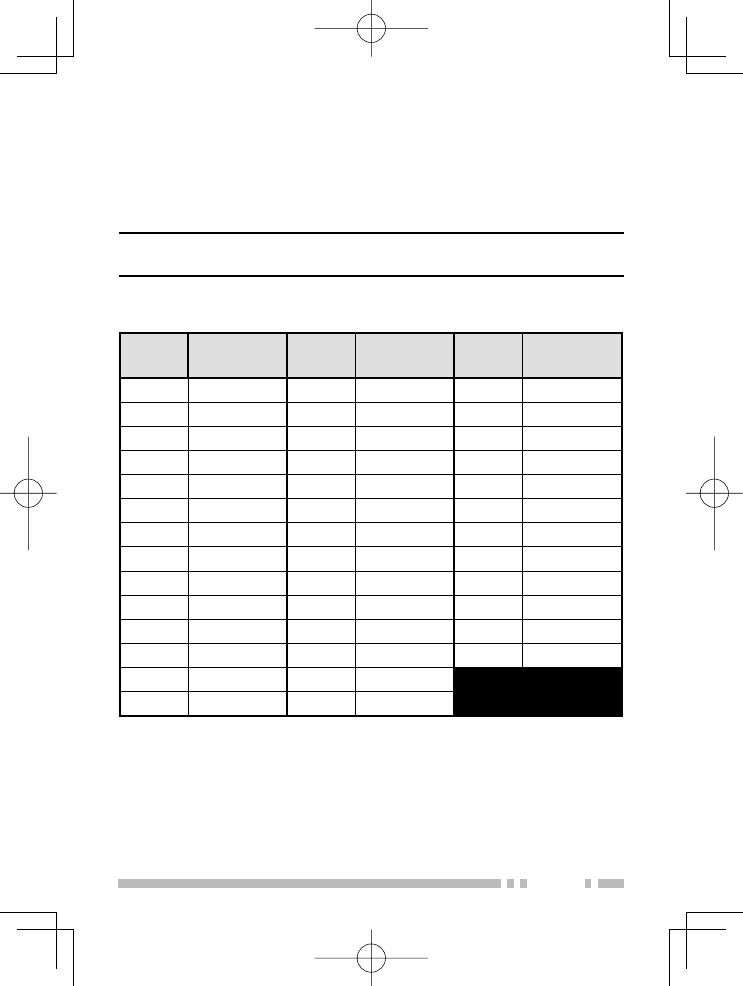
17
6 Press the PTT switch to save the setting.
• A beep will sound.
• Repeat steps 3 to 6 to set up another channel.
7 Turn the transceiver power OFF and then ON again to
activate the new settings.
Note: The transceiver will automatically return to normal operation
if no action is performed for 20 seconds.
QT Channel Settings:
QT
Number
QT
Frequency
QT
Number
QT
Frequency
QT
Number
QT
Frequency
167.0 Hz 15 110.9 Hz 29 179.9 Hz
271.9 Hz 16 114.8 Hz 30 186.2 Hz
374.4 Hz 17 118.8 Hz 31 192.8 Hz
477.0 Hz 18 123.0 Hz 32 203.5 Hz
579.7 Hz 19 127.3 Hz 33 210.7 Hz
682.5 Hz 20 131.8 Hz 34 218.1 Hz
785.4 Hz 21 136.5 Hz 35 225.7 Hz
888.5 Hz 22 141.3 Hz 36 233.6 Hz
991.5 Hz 23 146.2 Hz 37 241.8 Hz
10 94.8 Hz 24 151.4 Hz 38 250.3 Hz
11 97.4 Hz 25 156.7 Hz 39 69.3 Hz
12 100.0 Hz 26 162.2 Hz off OFF
13 103.5 Hz 27 167.9 Hz
14 107.2 Hz 28 173.8 Hz

18
DQT Channel Settings:
DQT
Number
DQT
Code
DQT
Number
DQT
Code
DQT
Number
DQT
Code
DQT
Number
DQT
Code
1D023N 31 D223N 61 D503N 91 D047I
2D025N 32 D226N 62 D506N 92 D051I
3D026N 33 D243N 63 D516N 93 D054I
4D031N 34 D244N 64 D532N 94 D065I
5D032N 35 D245N 65 D546N 95 D071I
6D043N 36 D251N 66 D565N 96 D072I
7D047N 37 D261N 67 D606N 97 D073I
8D051N 38 D263N 68 D612N 98 D074I
9D054N 39 D265N 69 D624N 99 D114I
10 D065N 40 D271N 70 D627N 100 D115I
11 D071N 41 D306N 71 D631N 101 D116I
12 D072N 42 D311N 72 D632N 102 D125I
13 D073N 43 D315N 73 D654N 103 D131I
14 D074N 44 D331N 74 D662N 104 D132I
15 D114N 45 D343N 75 D664N 105 D134I
16 D115N 46 D346N 76 D703N 106 D143I
17 D116N 47 D351N 77 D712N 107 D152I
18 D125N 48 D364N 78 D723N 108 D155I
19 D131N 49 D365N 79 D731N 109 D156I
20 D132N 50 D371N 80 D732N 110 D162I
21 D134N 51 D411N 81 D734N 111 D165I
22 D143N 52 D412N 82 D743N 112 D172I
23 D152N 53 D413N 83 D754N 113 D174I
24 D155N 54 D423N 84 D645N 114 D205I
25 D156N 55 D431N 85 D023I 115 D223I
26 D162N 56 D432N 86 D025I 116 D226I
27 D165N 57 D445N 87 D026I 117 D243I
28 D172N 58 D464N 88 D031I 118 D244I
29 D174N 59 D465N 89 D032I 119 D245I
30 D205N 60 D466N 90 D043I 120 D251I

19
DQT
Number
DQT
Code
DQT
Number
DQT
Code
DQT
Number
DQT
Code
DQT
Number
DQT
Code
121 D261I 134 D371I 147 D516I 160 D703I
122 D263I 135 D411I 148 D532I 161 D712I
123 D265I 136 D412I 149 D546I 162 D723I
124 D271I 137 D413I 150 D565I 163 D731I
125 D306I 138 D423I 151 D606I 164 D732I
126 D311I 139 D431I 152 D612I 165 D734I
127 D315I 140 D432I 153 D624I 166 D743I
128 D331I 141 D445I 154 D627I 167 D754I
129 D343I 142 D464I 155 D631I 168 D645I
130 D346I 143 D465I 156 D632I off OFF
131 D351I 144 D466I 157 D654I
132 D364I 145 D503I 158 D662I
133 D365I 146 D506I 159 D664I
CHANNEL CONFIRMATION MODE
To confirm your channel settings:
1 With the transceiver power OFF, press and hold the PTT
switch while turning the transceiver power ON.
• Continue to hold the PTT switch until the LED lights orange and
the transceiver announces “Confirm”.
2 Release the PTT switch.
• Transceiver announces the channel table number, tone
number, scrambler and VOX settings of the selected channel.
3 Rotate the Channel selector to your desired channel within
20 seconds, otherwise the operation will cancel.
• Transceiver announces the channel table number, tone
number, scrambler and VOX settings of the selected channel.
Note: The transceiver will automatically return to normal operation
if no action is performed for 20 seconds.

20
KEY ASSIGNMENT MODE
This transceiver allows you to reprogram the Side 1 and Side
2 keys with any of the functions listed in the table below.
Explanations on the use of each function are provided under
“PROGRAMMABLE FUNCTIONS”, on page 22.
Table Number Function Name
0None (no function)
1Calling Alert
2Key Lock
3Key Lock with Status Memory
4Monitor
5Monitor Momentary
6Scan
7Scan Temporary Delete (Side 2 key default)
8Scrambler
9Squelch Off
10 Squelch Off Momentary
11 Super Lock (Side 1 key default)
12 Low Transmit Power

21
To change the functions of the Side 1 and Side 2 keys:
1 With the transceiver power OFF, press and hold the Side 1
and Side 2 keys while turning the transceiver power ON.
• Continue to hold the Side 1 and Side 2 keys until the LED lights
orange and the transceiver announces “Setup”.
2 Continue to press and hold the key to be reprogrammed
(either the Side 1 or Side 2 key), while releasing the
remaining key.
• The transceiver will announce “Table zero”.
• If you continue to hold both keys, or if you release both keys,
the operation will cancel in 20 seconds.
3 Release the key.
4 Press the Side 1 or Side 2 key to increment/ decrement the
number, to select the new key function.
• Table numbers and their corresponding functions are provided
in the table on page 20.
• A voice announcement will inform you of the currently selected
Table number.
5 Press the PTT switch to save the setting.
• A beep will sound and the transceiver will announce the new
Table number.
6 Turn the transceiver power OFF and then ON again to
activate the new settings.
Note: The transceiver will automatically return to normal operation
if no action is performed for 20 seconds.

22
PROGRAMMABLE FUNCTIONS
■ Calling Alert
Calling alert tone helps alerting party members that you
are calling. To make a call, press the key programmed as
Calling Alert.
• Release the key to end the tone, and press and hold the PTT
switch to transmit and speak into the microphone.
■ Key Lock
Press and hold this key for 1 second to lock/ unlock the
transceiver keys.
The following keys/ functions can still be used when Key
Lock is active:
Calling Alert, Key Lock, Monitor, Monitor Momentary,
PTT, Squelch Off, Squelch Off Momentary, Selector,
Super Lock, Key Lock with Status Memory, and Volume
Control.
• When the transceiver power is turned OFF and then ON again,
the Key Lock function will be cancelled.
■ Key Lock with Status Memory
This operates the same as Key Lock except that when the
transceiver power is turned OFF and then ON again, the
keys remain locked. Without Status Memory, when the
transceiver power is turned OFF and then ON again, the
Key Lock function will be cancelled.
■ Monitor
Momentarily press this key to deactivate QT or DQT
signaling. Press the key again to return to normal operation.
■ Monitor Momentary
Press and hold this key to deactivate QT or DQT signaling.
Release the key to return to normal operation.

23
■ Scan
Scan is useful for monitoring signals on the transceiver
channels. When scanning, the transceiver checks for a
signal on each channel and only stops if a signal is present.
If the QT/DQT matches, the transceiver stops at the channel
and opens the squelch so you can listen to the call. If the
QT/DQT does not match, the call is ignored and scanning
continues.
■ Scan Temporary Delete (Side 2 key default)
Press this key to start scanning the transceiver channels.
When Scan pauses at an undesired channel, you can
remove that channel from the scanning sequence by
pressing and holding this key for 3 seconds.
■ Scrambler
Press this key to activate (a single beep sounds) and
deactivate (a double beep sounds) the scrambler function of
the selected channel.
The Scrambler function allows you to hold a conversation in
complete privacy. When the Scrambler function is activated,
any other party that is listening to your channel will be
unable to understand your conversation.
■ Squelch Off
Press this key to hear background noise. Press the key
again to return to normal operation.
■ Squelch Off Momentary
Press and hold this key to hear background noise. Release
the key to return to normal operation.

24
■ Super Lock (Side 1 key default)
Super Lock locks the same keys as Key Lock. Press and
hold this key for 4 seconds to lock the transceiver keys. To
deactivate Super Lock, with the transceiver power OFF,
press and hold the Side 2 key for 2 seconds while turning
the transceiver power ON.
• When the LED lights orange, release the Side 2 key.
A confirmation tone will sound.
■ Low Transmit Power
Press this key to change the transmit power to low power.
Each time you press this key, the transmit power toggles
between high and low.

25
TROUBLESHOOTING GUIDE
Problem Solution
Cannot turn the
transceiver power ON.
• The battery pack may be dead.
Recharge or replace the battery
pack.
• The battery pack may not be
installed correctly. Remove the
battery pack and install again.
Battery power dies shortly
after charging.
• The battery pack life is finished.
Replace the battery pack with a
new one.
Cannot talk to or hear
other members in your
group.
• Make sure you are using the
same frequency and QT/DQT
settings as the other members in
your group.
• Other group members may be
using the Scrambler function. Turn
on your transceiver’s Scrambler.
• Other group members may be
too far away. Make sure you
are within range of the other
transceivers.
Other voices (besides
group members’) are
present on the channel.
• Change the QT/DQT settings.
Make sure all group members
change the settings on their
transceivers to match the new
QT/DQT setting.

26
ALL RESET MODE
At some point in time, you may desire to reset the transceiver
settings to their default values. This function will reset all
channels to their default frequencies and QT/DQT, the VOX
function to its default status, and all keys to their default
functions.
To reset the transceiver:
1 With the transceiver power OFF, press and hold the PTT
switch, the Side 1 key, and the Side 2 key while turning the
transceiver power ON.
• Continue to hold the keys for 2 seconds, until the LED lights
orange.
2 Release the keys.
• The keys must be released within 2 second after the LED lights
orange, otherwise All Reset Mode will cancel.
• The transceiver announces “Confirm” and returns to normal
operation.
OPTIONAL ACCESSORIES
• KMC-21 (Speaker/ microphone)
• KMC-45 (Speaker/ microphone)
• KHS-1 (Headset)
• KHS-22 (Headset)
• KNB-45L (Li-ion battery pack))
• KSC-35S (Rapid charger)
• KSC-356 (Multiple charger)
• KBH-10 (Belt clip)
• KWR-1 (Water resistant bag)
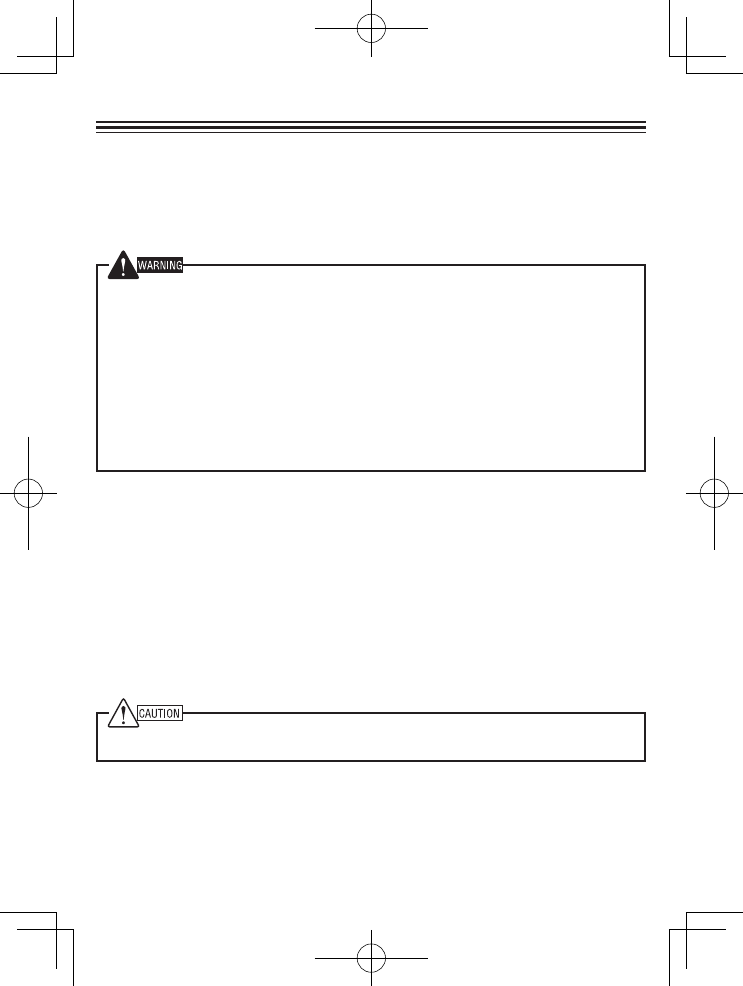
RADIO FREQUENCY ENERGY SAFETY INFORMATION
This Kenwood transceiver has been tested and complies with the standards listed below, in regards
to Radio Frequency (RF) energy and electromagnetic energy (EME) generated by the transceiver.
• FCC RF exposure limits for
Occupational Use Only
. RF Exposure limits adopted by the FCC are generally
based on recommendations from the National Council on Radiation Protection and Measurements, & the
American National Standards Institute.
• FCC OET Bulletin 65 Edition 97-01 Supplement C
• American National Standards Institute (C95.1 – 1992)
• American National Standards Institute (C95.3 – 1992)
This Kenwood transceiver generates RF EME while transmitting. RF EME (Radio Frequency Electric &
Magnetic Energy) has the potential to cause slight thermal, or heating effects to any part of your body less
than the recommended distance from this radio transmitter’s antenna. RF energy exposure is determined
primarily by the distance to and the power of the transmitting device. In general, RF exposure is minimized
when the lowest possible power is used or transmission time is kept to the minimum required for consistent
communications, and the greatest distance possible from the antenna to the body is maintained. The
Occupational Use Only
. Occupational/ controlled
exposure limits are applicable to situations in which persons are exposed to RF energy as a consequence
of their employment, and such persons have been made aware of the potential for exposure and can
exercise control over their exposure. This means you can use the transceiver only if you are aware of
the potential hazards of operating a transceiver and are familiar in ways to minimize these hazards. This
transceiver is not intended for use by the general public in uncontrolled environments. Uncontrolled
environment exposure limits are applicable to situations in which the general public may be exposed to RF
energy, or in which the persons who are exposed as a consequence of their employment may not be fully
aware of the potential for exposure or cannot exercise control over their exposure.
The following list provides you with the information required to ensure that you are aware of RF
exposure and of how to operate this transceiver so that the FCC RF exposure limitations are not
exceeded.
• While transmitting (holding the PTT switch or speaking with VOX enabled), always keep the antenna
and the radio at least 3 cm (1 3/16 inches) from your body or face, as well as from any bystanders. A
LED on the top of the radio shows red when the transmitter is operating in both PTT and VOX modes.
• Do not transmit for more than 50% of the total transceiver use time; transmitting over 50% of the total use
time may exceed the limits in accordance to the FCC RF exposure requirements. Nominal transceiver
operation is 5% transmission time, 5% reception time, and 90% stand-by time.
transceiver or another antenna authorized by Kenwood.
Use only Kenwood authorized accessories (antennas, battery packs, belt clips, Speaker/ Mics or
headsets etc.): When worn on the body, always place the radio in a Kenwood recommended clip or
carrying case meant for this product. The use of other than recommended or approved body- worn
accessories may result in RF exposure levels which exceed the FCC’s occupational/ controlled
environment RF exposure limits.
To ensure that your exposure to RF EME is within the FCC limits for occupational use, you must
observe and adhere to the above points.
Electromagnetic Interference Compatibility
Electronic devices are susceptible to electromagnetic interference (EMI) if they are not adequately
shielded or designed for electromagnetic compatibility. Because this transceiver generates RF
energy, it can cause interference to such equipment.
• Turn OFF your transceiver where signs are posted to do so. Hospitals and health care facilities use
equipment that is sensitive to electromagnetic radiation.
• Turn OFF your transceiver while on board an aircraft when so instructed. Use of the transceiver must
be in accordance with airline regulations and/or crew instructions. B59-2546-00